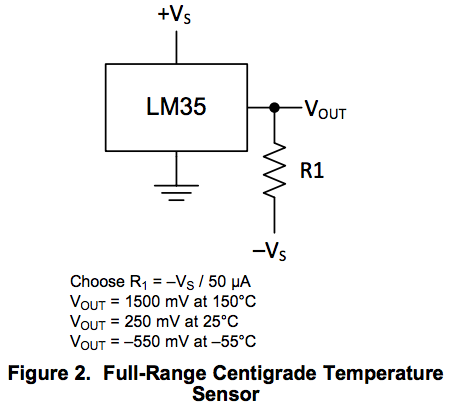Hello everyone. Long time lurker, first time poster here.
I'm looking to use the Texas Instruments LM35 temperature sensor to (yes, you guessed it) monitor ambient temperature in a refrigerator.
The overall goal is to eliminate the existing Temperature Control Knob and replace it with an Arduino controlled/triggered Solid State Relay. This will also allow me to have an LCD readout of the temperature and be able to "dial in" a Set/Desired Temperature via programming or some other source such as a potentiometer.
I'm looking to operate the LM35 in Full-Range (-55°C to 150°C). Figure 2 on page 1 of the datasheet (found here: http://www.ti.com/lit/ds/symlink/lm35.pdf) shows that a resistor must be added to the output of the LM35 in order for it to operate in Full-Range.
I'm confused as to what the other side of the resistor (labeled -Vs) should be connected to and how to figure out what size resistor I'll need being that I'm operating from a single supply. Also, what is the purpose of listing the different Vout ratings in this figure?
Here is Figure 2 from the datasheet:

Lastly, I just noticed Figure 18 on page 11 of the datasheet. Now I'm even more confused as to whether I should wire it up as shown in Figure 2 or Figure 18??? What's the difference between the two?
Figure 18:

Any help would be greatly appreciated.
I'm looking to use the Texas Instruments LM35 temperature sensor to (yes, you guessed it) monitor ambient temperature in a refrigerator.
The overall goal is to eliminate the existing Temperature Control Knob and replace it with an Arduino controlled/triggered Solid State Relay. This will also allow me to have an LCD readout of the temperature and be able to "dial in" a Set/Desired Temperature via programming or some other source such as a potentiometer.
I'm looking to operate the LM35 in Full-Range (-55°C to 150°C). Figure 2 on page 1 of the datasheet (found here: http://www.ti.com/lit/ds/symlink/lm35.pdf) shows that a resistor must be added to the output of the LM35 in order for it to operate in Full-Range.
I'm confused as to what the other side of the resistor (labeled -Vs) should be connected to and how to figure out what size resistor I'll need being that I'm operating from a single supply. Also, what is the purpose of listing the different Vout ratings in this figure?
Here is Figure 2 from the datasheet:

Lastly, I just noticed Figure 18 on page 11 of the datasheet. Now I'm even more confused as to whether I should wire it up as shown in Figure 2 or Figure 18??? What's the difference between the two?
Figure 18:

Any help would be greatly appreciated.





